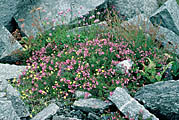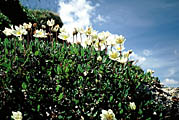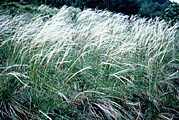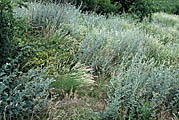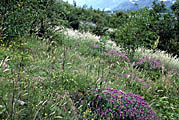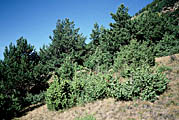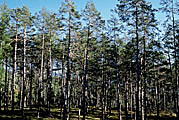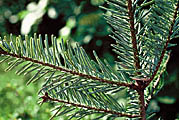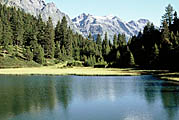 |
|
|
|
|
|
The following pollen diagram presents the main results of pollen analyses of an alluvial bog (Lai da Vons, Hinterrhein Valley in the Grisons, Swiss Central Alps) (Figure 1). A photograph shows the actual site (Figure 2). The landscape evolution of this site is illustrated with images (Figures 3 - 14) and for four time slices with four drawings (Effect on anscape evolution - Figure 1). The pollen diagram covers the last ca. 15'000 years (Oldest Dryas to Younger Subatlantic) and shows the following main steps of vegetation development: |
1 - Lai da Vons pollen |
2 - Mountain Lake Lai da Vons (1991 m, Upper Rhine valley, Switzerland). Right: the alluvial bog with the coring site. |
|
pioneer vegetation: herbs and some dwarf shrubs (wormwood/Artemisia, goosefoot family/Chenopodiaceae, genuine grasses/Poaceae, joint-pine/Ephedra). |
3 - Pioneer plant community of Fleischer's willow herb (Epilobietum fleischeri) of an Alpine glacier forefield. |
4 - Mountain avens (Dryas octopetala), a typical pioneer plant on calcareous debris cones and slopes. It is an excellent scree-stabiliser. |
|
5 - Joint-pine (Ephedra distachya ssp. helvetica) is a switch shrub of cliff steppe/ tundra on steep slopes in a semi-arid climate. It occurs as a glacial relict species in a few areas of the Alps. Fossil pollen occur mainly in late-glacial sediments. |
6 - Feathergrass (Stipa pennata), a typical grass species of cliff steppes; its fossil pollen occurs in late-glacial sediments (see also photo 9). |
| steppe/ Alpine tundra/ nurse crops: herbs, shrubs and first trees (wormwood, genuine grasses, herbs, juniper/Juniperus, sea buckthorn/Hippophae, birch/Betula, pine/Pinus). Immigration of birch and pine. |
7 - Juniper (Juniperus communis), a typical shrub of dry slopes and open forests. Fossil pollen can be found mainly in Late-Würmian sediments (e.g. Bölling interstadial). |
|
|
8 - Wormwood (Artemisia) steppe on open sunny and dry sites. Wormwood steppe and tundra were very wide-spread on ice-free areas during the Late-Würmian in Central Europe and the Alps. |
9 - Grass steppe with single shrubs, another analogy of Late-Würmian open vegetation. |
|
|
first dominance of pine: Scots pine/Pinus sylvestris, Swiss stone pine/Pinus cembra and mountain pine/P. mugo. Immigration of Swiss stone pine and European larch/Larix decidua. |
10 - Scots pine (Pinus sylvestris) and juniper (Juniperus communis) forming a small stand of trees on a sunny slope as an analogy of late-glacial reafforestation during the Bölling interstadial. |
11 - Closed Scots pine (Pinus sylvestris) forest as analogy of late-glacial reafforestation during the Alleröd interstadial. |
| second dominance of pine: Swiss stone pine, European larch and mountain pine. Immigration of Norway spruce/Picea abies, silver fir/Abies alba and green alder/Alnus viridis. |
12 - Subalpine Swiss stone pine (Pinus cembra) European larch (Larix decidua) forest. Val da Camp (Poschiavo valley, Grisons/ Switzerland). |
|
first dominance of spruce: Norway spruce, further silver fir. |
13 - Silver fir (Abies alba) needles with their typical white wax stripes. |
14 - Norway spruce (Picea abies) forest on the Lake of Dosso (1652 m; San Bernardino, Switzerland). |
| first dominance of alder: green alder. |
| first recession of tree pollen and dominance of NAP (=non arboreal pollen): genuine grasses, herb vegetation, green alder (climate oscillation: Piora cold phases I/II, first human impact at the forest limit). |
| second dominance of spruce: Norway spruce with silver fir. |
| second recession of tree pollen and dominance of NAP (climate oscillation: Göschenen cold phase I, human impact). |
| third dominance of spruce: Norway spruce, further silver fir. |
29 August 2011 |
||
| |
||


